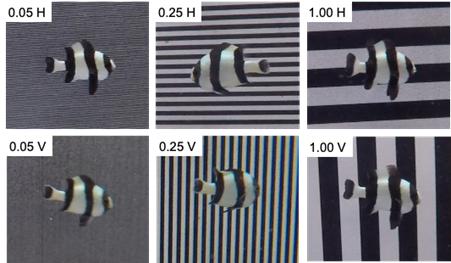Life isn’t easy under the sea, but luckily its resident creatures have evolved all sorts of clever tricks to keep themselves out of the jaws of predators. That includes the humbug damselfish, which new research suggests takes a much more complex approach to hiding from predators than previously thought – and it dazzles while doing so.
Humbug damselfish (Dascyllus aruanus) are reef-dwelling marine fish that, as the name implies, have striped black and white coloring. When they’re still, this candy-like appearance works well at blending them into their background – but they can’t stay still forever. They frequently have to move to eat, and it was widely suspected when they do, their stripes no longer afford them with camouflage.
But as scientists from Macquarie University’s School of Natural Sciences have become the first to discover, the stripes have more than one way of deceiving predators.
To determine this, the team placed humbug damselfish in a tank with backgrounds of varying stripe widths, filming how the fish responded to these different environments. This information was then fed into a computer model, which simulated how two different predators – a slingjaw wrasse and a coral trout – might see them.

It’s giving underwater Jailhouse Rock.
The results revealed that in situations where their camouflage might be less effective – the background stripes were thinner and more frequent – the humbugs moved more, generating an effect known as “motion dazzle”. This effect makes it more difficult for predators to accurately perceive the direction and speed of their prey.
“This motion dazzle is further enhanced when viewed against high contrast backgrounds which have similar spatial frequency and orientation to humbug stripes,” the team writes in the study describing the findings. “The edges of the humbugs are also harder to detect.”
That’s not all though – using data from the retinas of humbug damselfish, the team was also able to determine that the fish might be changing how they move in different environments based on being able to see those different environments.
This conclusion was further backed up by the finding that when humbugs were in tanks with backgrounds that had stripes similar to their own, they moved closer to it and reduced their movement – in other words, increasing motion dazzle via their background rather than through their movement.
“This suggests that humbugs can see different backgrounds and might then change their behaviour to improve their protection from predators,” said study author Dr Louise Tosetto in a statement.
The next step for the team is to figure out if there’s anything else that might be enhancing the damselfish’s dazzling capabilities.
“Future research should investigate how factors like the water’s light-filtering properties and interactions with other damselfish might affect motion dazzle,” said fellow author Dr Laura Ryan. “The humbug damselfish offers a perfect model to explore these important questions.”
The study is published in PeerJ.
Source Link: Underwater Humbug Confuses Predators By Giving Them The Ol’ Razzle Dazzle